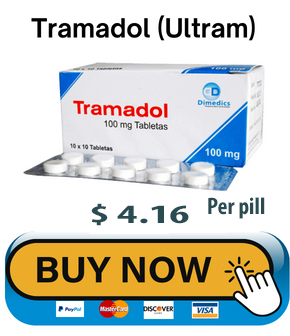| Product Name: | Tramadol (Ultram) |
| Strength: | 50mg , 100 mg , 200 mg |
| Available packages: | 30, 60, 90, 120, 160, 200, 250, 300 pills |
| Payment Method: | E-Check | MASTERCARD |
| Price per pill: | From $4.85 |
| Shipment: | Express Delivery Service |
| Buy Now From: | Open Pill Pharmacy no Rx |
I. Buy Tramadol Online – Order Ultram Without Prescription
I. Introduction
What is Tramadol ?
Tramadol is a synthetic opioid analgesic medication used primarily to manage moderate to severe pain. It was first synthesized in the late 1970s by Grünenthal GmbH, a German pharmaceutical company, and introduced to the market in the early 1990s under the brand name Ultram. Tramadol is unique among opioids due to its dual mechanism of action, acting as both a mu-opioid receptor agonist and a serotonin-norepinephrine reuptake inhibitor (SNRI).
History of Tramadol Tramadol’s development stemmed from efforts to create a potent analgesic with fewer side effects and less abuse potential compared to traditional opioids. Its approval by regulatory agencies such as the U.S. Food and Drug Administration (FDA) marked a significant advancement in pain management pharmacotherapy.
II. Pharmacology
Mechanism of Action Tramadol exerts its analgesic effects through two primary mechanisms: mu-opioid receptor agonism and inhibition of serotonin and norepinephrine reuptake in the central nervous system. By activating mu-opioid receptors and increasing the availability of serotonin and norepinephrine, tramadol modulates pain perception and processing.
Pharmacokinetics After oral administration, tramadol is rapidly absorbed from the gastrointestinal tract, with peak plasma concentrations reached within 1-2 hours. Its bioavailability is approximately 70%, and it undergoes extensive hepatic metabolism via various cytochrome P450 enzymes. The major metabolite, O-desmethyltramadol (M1), exhibits greater affinity for mu-opioid receptors than the parent compound.
Metabolism Tramadol is primarily metabolized in the liver by cytochrome P450 enzymes, particularly CYP2D6 and CYP3A4. Genetic polymorphisms in these enzymes can influence tramadol metabolism and contribute to interindividual variability in drug response and efficacy.
III. Medical Uses
Pain Management
Tramadol is indicated for the management of moderate to moderately severe pain, including acute and chronic pain conditions. Its dual mechanism of action provides analgesia comparable to that of other opioids while potentially reducing the risk of respiratory depression and dependence.
Off-label Uses
In addition to its approved indications, tramadol is sometimes used off-label for the treatment of neuropathic pain, fibromyalgia, and post-operative pain. Its efficacy in these conditions stems from its ability to modulate neurotransmitter pathways involved in pain processing.
IV. Dosage and Administration
Standard Dosage Guidelines
The usual starting dose of tramadol for adults is 50-100 mg orally every 4-6 hours as needed for pain relief. Dosage adjustments may be necessary based on individual response and tolerance, with a maximum daily dose of 400 mg for immediate-release formulations and 300 mg for extended-release formulations.
Forms of Administration
Tramadol is available in various formulations, including immediate-release tablets, extended-release tablets, and oral solutions. The choice of formulation depends on factors such as the severity of pain, duration of analgesia needed, and patient preference.
V. Side Effects and Adverse Reactions
Common Side Effects
Common side effects of tramadol include nausea, dizziness, constipation, headache, and drowsiness. These effects are usually mild to moderate in severity and often diminish with continued use.
Less Common Side Effects
Less common side effects may include sweating, dry mouth, fatigue, and gastrointestinal disturbances. Although less frequent, these adverse reactions should be monitored and reported to healthcare providers if persistent or severe.
Serious Adverse Reactions
Serious adverse reactions associated with tramadol use include serotonin syndrome, seizures, respiratory depression, and allergic reactions. Patients with a history of epilepsy, substance abuse, or sensitivity to opioids should use tramadol with caution and under close medical supervision.
Drug Interactions
Tramadol has the potential to interact with other medications, particularly those that affect cytochrome P450 enzymes or serotoninergic neurotransmission. Concomitant use of tramadol with selective serotonin reuptake inhibitors (SSRIs), monoamine oxidase inhibitors (MAOIs), or other serotonergic agents may increase the risk of serotonin syndrome.
VI. Precautions and Warnings
Contraindications
Tramadol is contraindicated in patients with a history of hypersensitivity to tramadol or opioids and in those with acute intoxication with alcohol, hypnotics, centrally acting analgesics, opioids, or psychotropic drugs. It should not be used in patients with severe respiratory depression, severe hepatic impairment, or paralytic ileus.
Special Populations
Special consideration should be given to specific patient populations when prescribing tramadol. Pregnant women, nursing mothers, pediatric patients, and geriatric patients may require dosage adjustments or closer monitoring due to differences in drug metabolism, pharmacokinetics, and susceptibility to adverse effects.
Risk of Dependence and Abuse
Tramadol carries a risk of dependence, tolerance, and abuse, particularly with long-term or high-dose use. Patients with a history of substance abuse or addiction should be closely monitored during tramadol therapy, and treatment should be tapered gradually when discontinuation is warranted to minimize withdrawal symptoms.
VII. Overdose and Management
Symptoms of Overdose
Overdose of tramadol may manifest as respiratory depression, somnolence, coma, seizures, and cardiac arrest. The risk of overdose is increased in patients with impaired hepatic or renal function, concurrent use of other CNS depressants, or misuse of tramadol.
Treatment of Overdose
Management of tramadol overdose involves supportive care and symptomatic treatment, including airway management, respiratory support, administration of naloxone (opioid antagonist) if necessary, and monitoring for complications such as seizures or cardiac arrhythmias.
VIII. Regulatory Status and Legal Issues
Prescription Status Tramadol is a prescription medication and is classified as a Schedule IV controlled substance in the United States due to its potential for abuse and dependence. It is available only with a healthcare provider’s prescription and should be used under medical supervision.
IX. Future Directions and Research
Ongoing Studies Ongoing research is focused on further elucidating tramadol’s mechanisms of action, optimizing its therapeutic efficacy and safety profile, and exploring novel indications for its use. Clinical trials are underway to investigate tramadol’s potential in conditions such as opioid withdrawal management, psychiatric disorders, and neuropathic pain syndromes.
Potential Developments
Future developments in tramadol pharmacotherapy may include the development of novel formulations with improved pharmacokinetic properties, targeted delivery systems, and combination therapies with adjuvant analgesics or non-pharmacological interventions. These advancements aim to enhance pain management outcomes while minimizing adverse effects and risks associated with long-term opioid therapy.
X. Conclusion
What is Tramadol ? What is Ultram?
Tramadol is a synthetic opioid analgesic with dual mechanisms of action, providing analgesia through mu-opioid receptor agonism and serotonin-norepinephrine reuptake inhibition. It is indicated for the management of moderate to moderately severe pain and is available in various formulations for oral administration.
Why Is Tramadol Important in Pain Management?
Tramadol plays a valuable role in pain management pharmacotherapy
Customer Review
Ryan, Arizona
Ativan has been effective in controlling my seizures, but the sedative effects can be quite strong. I’ve had to adjust my dosage to find the right balance between seizure control and drowsiness.
Melissa, Colorado
I was prescribed Ativan for my panic attacks, and it works like a charm. It calms me down almost instantly and allows me to regain control of my thoughts and emotions.
Kevin, Washington
Lorazepam helps me manage my insomnia, but I try not to rely on it too often due to the risk of tolerance and dependence. It’s great for occasional use, but not something I want to take every night

